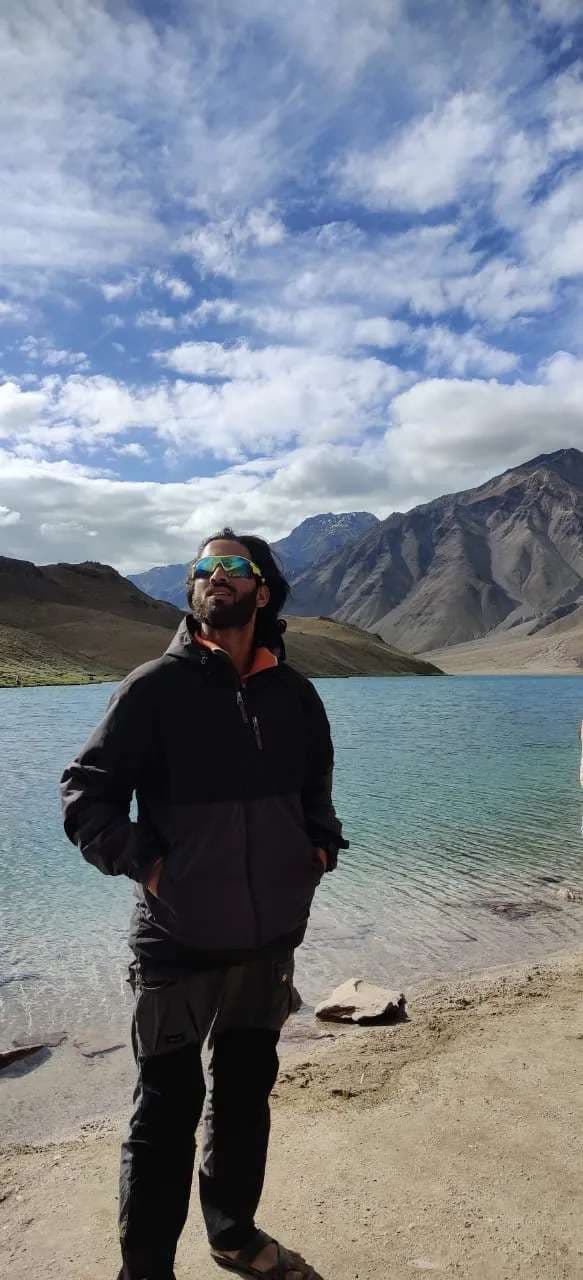The Naranag Mahlish Trek is located in the Kashmir Valley of Jammu and Kashmir, India. The trek begins from the village of Naranag, situated in the Ganderbal district, and proceeds towards Mahlish Meadow. The altitude of Naranag is approximately 2,135 meters (7,005 feet) above sea level, while Mahlish Meadow is situated at around 3800m/12467.192ft. It is 6 days trek. Therefore, the trek involves ascending to an altitude of over 1,000 meters (3,280 feet). The Naranag Mahlish Trek is considered to be of moderate difficulty. While the trail is well-defined and does not involve technical climbing, trekkers need to be prepared for some steep ascents and descents, as well as navigating through rocky terrain and occasional streams. Acclimatization to the altitude is also essential, especially for those not accustomed to higher elevations.
The best time to undertake the Naranag Mahlish Trek is during the summer months, from June to September. During this period, the weather is generally pleasant, with clear skies and mild temperatures, making it ideal for trekking. It is advisable to avoid the monsoon season (July-August) due to the possibility of heavy rainfall, which can make the trails slippery and difficult to traverse. Additionally, the winter months (November to April) are not recommended for trekking in this region due to heavy snowfall and harsh weather conditions.
The Naranag Mahlish Trek is a captivating journey that takes trekkers through the pristine landscapes of Kashmir, offering an immersive experience amidst the natural beauty of the region. The trek typically starts from the quaint village of Naranag, known for its historical significance and stunning surroundings. From Naranag, trekkers traverse through picturesque valleys, dense forests, and alpine meadows, encountering gushing streams and majestic mountain vistas along the way. The trail leads to the serene Mahlish Meadow, where trekkers can camp amidst the tranquil surroundings and soak in the breathtaking views of the surrounding peaks. The Naranag Mahlish Trek is renowned for its scenic beauty, diverse terrain, and the opportunity to witness the rich flora and fauna of the Kashmir Valley. It offers trekkers a chance to disconnect from the hustle and bustle of daily life and immerse themselves in the serene wilderness of the Himalayas, creating memories that last a lifetime.
Best time for Narang Mahlish Trek
The best time to embark on the Naranag Mahlish Trek is during the summer months, specifically from June to September. During this period, the weather in the Kashmir Valley is generally favorable for trekking, with clear skies, mild temperatures, and minimal precipitation. The trails are usually in good condition, making it easier for trekkers to navigate through the picturesque landscapes of the region.
It's essential to avoid the monsoon season, typically from July to August, as heavy rainfall can lead to slippery trails and difficult trekking conditions. Additionally, the winter months, from November to April, are not suitable for trekking in this region due to heavy snowfall and extremely cold temperatures, which can pose safety hazards for trekkers.
Therefore, planning your Naranag Mahlish Trek during the summer months ensures a more enjoyable and safer experience, allowing you to fully appreciate the natural beauty and serenity of the Kashmir Valley.
How to reach Srinagar
To reach Srinagar, the capital city of Jammu and Kashmir, there are several transportation options available:
1. By Air: Srinagar has its own airport, Sheikh ul-Alam International Airport (SXR), which is well-connected to major cities across India such as Delhi, Mumbai, Bangalore, and Kolkata, as well as some international destinations. From the airport, you can easily hire a taxi or take a pre-paid taxi to reach your desired destination within Srinagar.
2. By Road: Srinagar is connected to other major cities in North India by a network of national highways. You can travel to Srinagar by road via Jammu, which is approximately 270 kilometers away and takes around 8-10 hours by car, depending on road conditions and traffic. Private buses, as well as state-run buses operated by Jammu and Kashmir State Road Transport Corporation (JKSRTC), also ply between Srinagar and other nearby cities.
3. By Rail: The nearest railway station to Srinagar is in Jammu, known as Jammu Tawi Railway Station (JAT), which is well-connected to major cities across India by regular train services. From Jammu, you can hire a taxi or take a bus to reach Srinagar, which is approximately an 8-10 hour journey by road.
Once you arrive in Srinagar, you can explore the city and its surrounding areas by local transport such as taxis, auto-rickshaws, and buses. Additionally, many hotels and guesthouses offer pick-up and drop-off services for their guests.
Difficulty level of Narang Mahlish trek
The difficulty level of the Naranag Mahlish trek is generally considered to be moderate. Here's why:
1. Terrain: The trail involves a variety of terrain, including rocky paths, steep ascents and descents, and occasional stream crossings. While the paths are well-defined, trekkers should be prepared for some challenging sections.
2. Altitude: The trek involves gaining altitude from Naranag to Mahlish Meadow, with Mahlish Meadow situated at around 3,300 meters (10,827 feet) above sea level. Altitude sickness can be a concern for some trekkers, so proper acclimatization and hydration are essential.
3. Duration: The trek typically takes around 3-4 days to complete, covering a distance of approximately 15-20 kilometers. Trekking for multiple days with overnight stays in tents or campsites requires endurance and stamina.
4. Weather: Weather conditions in the Kashmir Valley can be unpredictable, with sudden changes in temperature and occasional rainfall, especially during the monsoon season. Trekkers should be prepared for varying weather conditions and pack accordingly.
While the Naranag Mahlish trek is suitable for most moderately fit individuals with some trekking experience, beginners may find it challenging due to the altitude and terrain. It's important to be adequately prepared, physically and mentally, and to pace oneself while trekking. Additionally, hiring a local guide or joining a trekking group can enhance the overall experience and ensure safety on the trail.
How to prepare for Narang Mahlish Trek
Preparing for the Naranag Mahlish Trek involves several key steps to ensure a safe and enjoyable experience. Here's a comprehensive guide to help you prepare:
1. Physical Fitness: The trek involves walking for several hours each day and ascending to higher altitudes. Therefore, it's essential to build your stamina and endurance through regular cardiovascular exercises such as walking, jogging, cycling, or hiking. Incorporate strength training exercises to strengthen your leg muscles, core, and upper body.
2. Acclimatization: Since the trek involves ascending to higher altitudes, acclimatization is crucial to prevent altitude sickness. If possible, spend a couple of days in Srinagar or nearby areas before starting the trek to allow your body to adjust to the altitude. Stay hydrated, avoid alcohol and caffeine, and ascend gradually during the trek.
3. Packing Essentials: Pack lightweight and moisture-wicking clothing suitable for layering, as weather conditions can vary throughout the trek. Essentials include trekking pants, moisture-wicking t-shirts, thermal wear, fleece jackets, a waterproof and windproof jacket, sturdy hiking boots with ankle support, woolen socks, gloves, sun hat, sunglasses, sunscreen, lip balm, personal toiletries, a lightweight sleeping bag, a sturdy backpack, trekking poles, water bottles or hydration bladder, first aid kit, insect repellent, headlamp or flashlight, and snacks.
4. Trekking Permits: Obtain any necessary permits or permissions required for the trek beforehand. Check with local authorities or trekking agencies for information on permits and regulations.
5. Guides and Porters: Consider hiring a local guide or porter familiar with the trekking route, especially if you're unfamiliar with the area or trekking at higher altitudes. A guide can provide valuable insights into the local culture, flora, and fauna, while a porter can help carry your belongings, allowing you to trek with less weight on your back.
6. Weather Check: Monitor weather forecasts for the region and plan your trek accordingly. Be prepared for sudden changes in weather and pack appropriate gear for rain, cold, and sun protection.
7. Stay Hydrated and Nourished: Drink plenty of water throughout the trek to stay hydrated, especially at higher altitudes where dehydration can occur more quickly. Pack high-energy snacks such as nuts, energy bars, chocolates, and dried fruits to keep your energy levels up during the trek.
8. Respect Local Customs and Environment: Familiarize yourself with local customs, traditions, and environmental guidelines before embarking on the trek. Respect local culture, wildlife, and natural surroundings, and leave no trace behind.
By following these preparation tips, you'll be well-equipped to embark on the Naranag Mahlish Trek and make the most of your adventure in the beautiful Kashmir Valley.
Safety considerations for Narang Mahlish trek
Ensuring safety during the Naranag Mahlish trek is paramount to have an enjoyable and incident-free experience. Here are some important safety considerations to keep in mind:
1. Physical Fitness: Assess your physical fitness level before embarking on the trek. Ensure that you are adequately prepared for the physical demands of walking long distances and ascending to higher altitudes.
2. Acclimatization: Take sufficient time to acclimatize to the altitude before starting the trek. Spend a few days in Srinagar or nearby areas to allow your body to adjust gradually to the higher elevation.
3. Weather Conditions: Monitor weather forecasts before and during the trek. Be prepared for sudden changes in weather, including rain, snow, and strong winds. Dress in layers to stay warm and dry, and carry waterproof and windproof clothing.
4. Altitude Sickness: Be aware of the symptoms of altitude sickness, including headache, nausea, dizziness, and fatigue. Ascend gradually, stay hydrated, and avoid overexertion. If you experience severe symptoms of altitude sickness, descend to a lower altitude immediately and seek medical attention if necessary.
5. Trekking Permits: Ensure that you have obtained any necessary permits or permissions required for the trek. Check with local authorities or trekking agencies for information on permits and regulations.
6. Navigation: Familiarize yourself with the trekking route and carry a detailed map, GPS device, or smartphone with GPS capabilities. Stay on marked trails and avoid straying off the designated path.
7. Emergency Contacts: Carry a list of emergency contacts, including local authorities, emergency services, and your trekking agency or guide. Share your itinerary with family or friends and establish regular check-in points if possible.
8. First Aid Kit: Carry a well-stocked first aid kit containing essential supplies such as bandages, antiseptic wipes, pain relievers, blister pads, and any personal medications you may need.
9. Hydration and Nutrition: Stay hydrated by drinking plenty of water throughout the trek. Pack high-energy snacks to maintain your energy levels, and ensure you have an adequate supply of food and water for the duration of the trek.
10. Group Travel: Whenever possible, trek in a group or with a knowledgeable guide. Traveling with others enhances safety and provides support in case of emergencies.
By prioritizing safety and taking necessary precautions, you can enjoy a rewarding and memorable trekking experience on the Naranag Mahlish trail.












































